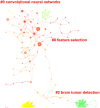Telemedicine in Arab Countries: Innovation, Research Trends, and Way Forward
- PMID: 34713071
- PMCID: PMC8521801
- DOI: 10.3389/fdgth.2020.610837
Telemedicine in Arab Countries: Innovation, Research Trends, and Way Forward
Abstract
Background: The progress and innovation in telemedicine within the Middle Eastern countries have not been heavily monitored. Therefore, the present study aims to analyze the scholarly work conducted in the Arab world, using reproducible statistical and scientometric techniques. Methods: An electronic search of Web of Science (core database) had been conducted through use of an extensive search strategy comprising of keywords specific to the Arab region, EMRO countries, telehealth, medical conditions, and disorders. A total yield of 1,630 search results were processed, indexed through July 7, 2020. CiteSpace (5.7.R1, Drexel University, Pennsylvania, USA) is a Java-based application, a user-friendly tool for conducting scientometric analyses. Results: The present analyses found a lack of innovation in the field of digital health in the Arab countries. Many gaps in research were found in Arab countries, which will be discussed subsequently. Digital health research was clustered around themes of big data and artificial intelligence; a lack of progress was seen in telemedicine and digital health. Furthermore, only a small proportion of these publications had principal or corresponding authors from Arab countries. A clear disparity in digital health research in the Arab world was evident after comparing these insights with our previous investigation on telemedicine research in the global context. Conclusion: Telemedicine research is still in its infancy in the Middle Eastern countries. Recommendations include diversification of the research landscape and interdisciplinary collaborations in this area.
Keywords: Middle East; bibliometric; digital health; research policy; scientometric; telemedicine.
Copyright © 2021 Waqas, Mehmood, Jawwad, Pittam, Kundu, Correia and AlMughamis.
Conflict of interest statement
The authors declare that the research was conducted in the absence of any commercial or financial relationships that could be construed as a potential conflict of interest.
Figures







Similar articles
-
Harnessing Telemedicine for the Provision of Health Care: Bibliometric and Scientometric Analysis.J Med Internet Res. 2020 Oct 2;22(10):e18835. doi: 10.2196/18835. J Med Internet Res. 2020. PMID: 33006571 Free PMC article.
-
Telemedicine Research Trends in 2001-2022 and Research Cooperation Between China and Other Countries Before and After the COVID-19 Pandemic: Bibliometric Analysis.Interact J Med Res. 2024 Aug 30;13:e40801. doi: 10.2196/40801. Interact J Med Res. 2024. PMID: 39213010 Free PMC article.
-
Prostate cancer in the Arab world: Bibliometric review and research priority recommendations.Arab J Urol. 2022 Jan 23;20(2):81-87. doi: 10.1080/2090598X.2021.2024984. eCollection 2022. Arab J Urol. 2022. PMID: 35530565 Free PMC article.
-
The Arab Region's Contribution to Global Mental Health Research (2009-2018): A Bibliometric Analysis.Front Psychiatry. 2020 Mar 19;11:182. doi: 10.3389/fpsyt.2020.00182. eCollection 2020. Front Psychiatry. 2020. PMID: 32265754 Free PMC article.
-
Nursing and midwifery research activity in Arab countries from 1950 to 2017.BMC Health Serv Res. 2019 May 28;19(1):340. doi: 10.1186/s12913-019-4178-y. BMC Health Serv Res. 2019. PMID: 31138250 Free PMC article. Review.
Cited by
-
Digital health in fragile states in the Middle East and North Africa (MENA) region: A scoping review of the literature.PLoS One. 2023 Apr 28;18(4):e0285226. doi: 10.1371/journal.pone.0285226. eCollection 2023. PLoS One. 2023. PMID: 37115778 Free PMC article.
-
Physicians' Perspective of Telemedicine Regulating Guidelines and Ethical Aspects: A Saudi Experience.Int J Telemed Appl. 2022 Oct 12;2022:5068998. doi: 10.1155/2022/5068998. eCollection 2022. Int J Telemed Appl. 2022. PMID: 36278028 Free PMC article.
-
Arabic Digits-in-Noise Tests: Relations to Hearing Loss and Comparison of Diotic and Antiphasic Versions.Trends Hear. 2025 Jan-Dec;29:23312165251320439. doi: 10.1177/23312165251320439. Epub 2025 Mar 21. Trends Hear. 2025. PMID: 40116787 Free PMC article.
-
The Impact of COVID-19 on the Prevalence and Perception of Telehealth Use in the Middle East and North Africa Region: Survey Study.JMIR Form Res. 2023 Feb 2;7:e34074. doi: 10.2196/34074. JMIR Form Res. 2023. PMID: 36652596 Free PMC article.
-
The Efficacy of Telehealth Versus In-Person Management Delivery in Adult Patients with Obesity.Healthcare (Basel). 2024 Nov 4;12(21):2190. doi: 10.3390/healthcare12212190. Healthcare (Basel). 2024. PMID: 39517400 Free PMC article.
References
-
- World Health Organization . Global Diffusion of eHealth: Making Universal Health Coverage Achievable. Report of the Third Global Survey on eHealth Global Observatory for eHealth. WHO; (2016). Available online at: http://who.int/goe/publications/global_diffusion/en/ (accessed September 7, 2021).
LinkOut - more resources
Full Text Sources

